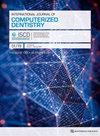不同牙体修复体的口内扫描精度和准确性。
IF 2
4区 医学
Q2 DENTISTRY, ORAL SURGERY & MEDICINE
引用次数: 0
摘要
目的:研究不同牙体材料数字印模的准确性。它比较了由经验丰富的临床医生操作的手持式扫描仪、由机械臂操作的手持式扫描仪和桌面扫描仪的扫描精度和真实性。通过测量三组内的三角形数、平均度和顶点数,可以得出不同扫描方法对数字模型的精度结论。材料与方法:采用各种牙科材料制作的标准尺寸模型。测试的扫描仪包括台式扫描仪、由经验丰富的临床医生操作的手持扫描仪和由机械臂操作的手持扫描仪。记录并比较三角形数、平均度和顶点数。进行统计学分析以确定组间的显著差异。结果:桌面扫描仪在数字模型中产生的三角形最少,而由经验丰富的临床医生操作的手持式扫描仪产生的三角形最多。不同修复体的三角数、平均度、顶点数均有显著差异。经验丰富的临床医生使用的手持式扫描仪产生的数字模型最准确、最真实,其次是机械臂操作的手持式扫描仪,然后是桌面扫描仪。不同牙材的使用显著影响数字印模的准确性。结论:本研究强调了使用各种牙科材料和扫描仪进行数字印模的准确性和真实性。研究结果表明,操作员的经验和扫描仪类型影响数字印模精度。这些见解对临床实践具有启示意义,表明需要进一步的研究来证实这些结果并探索牙科数字印模的其他影响因素。本文章由计算机程序翻译,如有差异,请以英文原文为准。
WITHDRAWN: Intraoral scanning accuracy and trueness for different dental restorations.
This article has been withdrawn at the request of the author(s).
求助全文
通过发布文献求助,成功后即可免费获取论文全文。
去求助
来源期刊

International Journal of Computerized Dentistry
Dentistry-Dentistry (miscellaneous)
CiteScore
2.90
自引率
0.00%
发文量
49
期刊介绍:
This journal explores the myriad innovations in the emerging field of computerized dentistry and how to integrate them into clinical practice. The bulk of the journal is devoted to the science of computer-assisted dentistry, with research articles and clinical reports on all aspects of computer-based diagnostic and therapeutic applications, with special emphasis placed on CAD/CAM and image-processing systems. Articles also address the use of computer-based communication to support patient care, assess the quality of care, and enhance clinical decision making. The journal is presented in a bilingual format, with each issue offering three types of articles: science-based, application-based, and national society reports.
 求助内容:
求助内容: 应助结果提醒方式:
应助结果提醒方式:


